





Published on Sep 12, 2023
. In my project, I tried to find out if the price and vitamin C content of fruits will affect how fast they rot. I think the fruit with the most vitamin C content will rot first and the price of the fruit will have no effect.
My experiment is based on which fruits rot first based on characteristics. So I used price and vitamin c as characteristics to find out which fruits rot first. I decided to this experiment because I thought that it would be fun to do a virtual science fair based on fruits and mold.
To find out if the price and vitamin C content of fruits will affect how fast they rot.
I think the fruit with the most vitamin C content will rot first and the price of the fruit will have no effect.
1. A paper and pencil to write down results
2. Camera to take pictures
3. 2 strawberries
4. 5 blueberries
5. 1 honey tangerine
6. 1 sunburst tangerine
7. 1 stem and leaf clementine
8. 1 boxed clementine
9. 3 grapes
10. 7 Ziploc plastic bags to put the fruits in
11. 2 trays to put the fruits on
12. A knife to cut the fruits
13. A chopping board to cut the fruits on
14. 5 labels
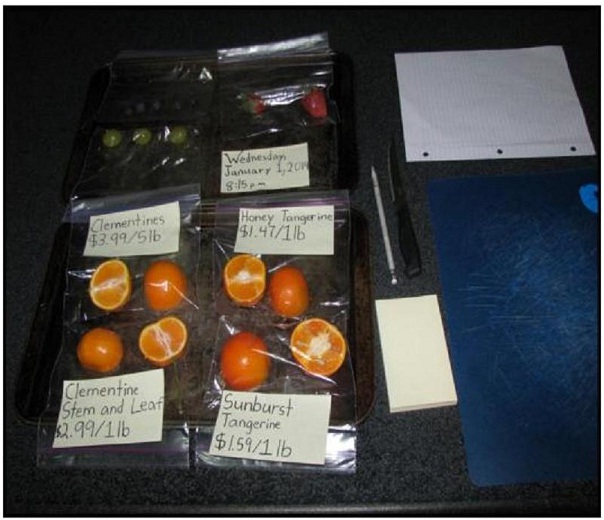
1. Get all the materials that are needed for the experiment.
2. Put 2 strawberries in a Ziploc plastic bag and label the bag “Strawberries”. Then put 5 blueberries in another Ziploc plastic bag and label the bag “Blueberries”. Next put 3 grapes in another Ziploc plastic bag and label the bag “Grapes”. After that, put a label on the tray and write the time and date on it so that you know when you started the project. Then take a picture of each fruit in its Ziploc plastic bag. Next, put the fruit bags on a tray and leave them in a warm, dark, and dry area.
3. Next, get the honey tangerine and cut it in half. Then put them in a Ziploc plastic bag.
4. Do step 3 again three times, substituting honey tangerine with sunburst tangerine, stem and leaf clementine, and boxed clementine. Then put the fruit bags on a tray in a warm, dark, and dry area.
5. Each day for two weeks, observe fruits for any changes in its appearance, take a picture, and record all observations on a piece of paper.
6. After 2 weeks, take a picture of each fruit in its Ziploc plastic bag. Then throw out all the Ziploc plastic bags including the fruits in it.
Clementine Stem and Leaf: The clementine started to mold on day 5 with 3 very small black dots. By day 7, 2 more black dots of mold had appeared. From day 10-14, there were 4 patches of light greenish mold, 4 black dots, and 1 medium black dot.
Sunburst Tangerine: The tangerine started to mold on day 7 with 1 greenish small dot of mold on the seed. It kept on growing and on day 12, the seed was completely covered with greenish mold. On day 14, there was a big patch of greenish mold around the seed.
Honey Tangerine: The tangerine started to mold on day 7 with one small dot of greenish mold. The next day, there was a big dot of mold which was shaped like a triangle. From day 10-14, there was a medium patch of mold and a big line of mold.
Clementines: The clementines started to mold on day 5 with 1 greenish, medium-sized dot and 2 small greenish dots. On day 7, the medium dot grew into a bigger dot. The next day, the small dots turned to medium dots. On day 14, there were 5 small dots and one huge dot
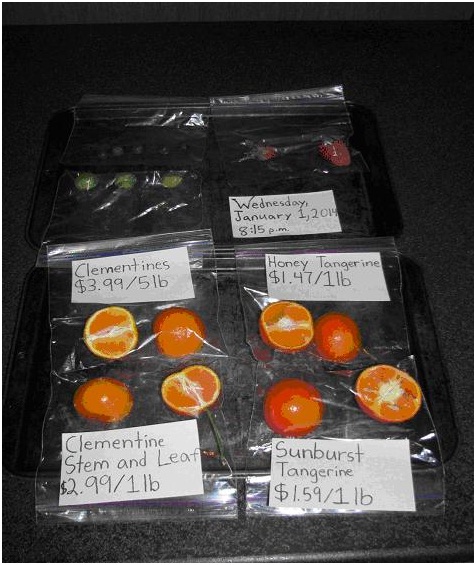
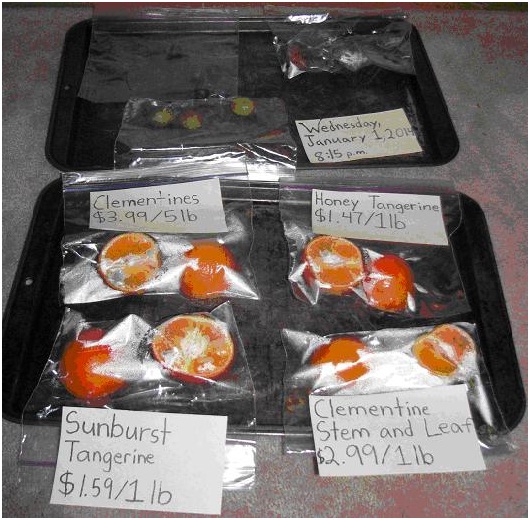
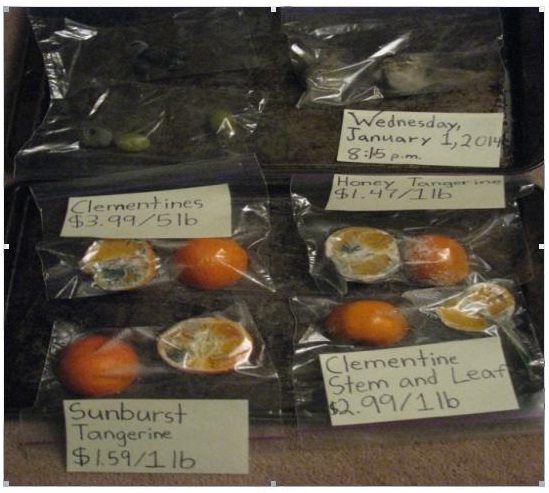
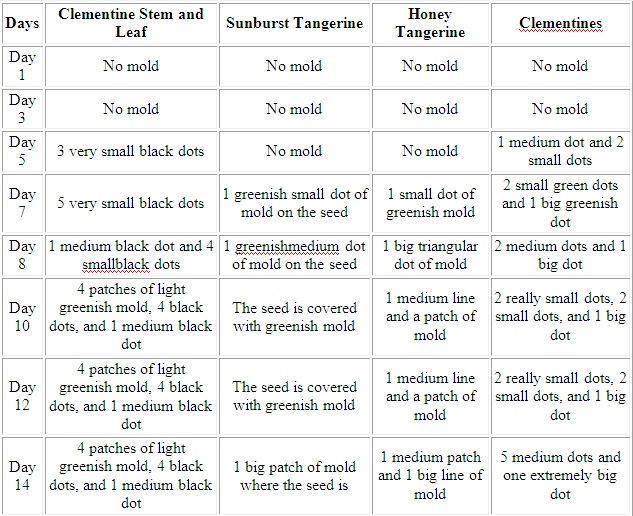
For price, my hypothesis is partially correct. The price of the fruit partially affects how fast they rot. Clementines, the cheapest, molded first. Clementine Stem and Leaf, the most expensive, molded second. Sunburst Tangerine, the 2nd most expensive, and Honey Tangerine, the 2nd cheapest, rotted together. In conclusion, I found out that price partially affects how fast a tangerine or clementine will rot. To my surprise, both clementines rotted before both tangerines, regardless of its price. I think it is best to buy a fruit that is not too expensive and not too cheap.
For vitamin C, my hypothesis is partially correct because vitamin C partially affects how fast a fruit will rot. Blueberries, which contain the 2nd most amount of vitamin C, rotted first. Strawberries, which contain the most amount of vitamin C, rotted next. Grapes, which contain the least amount of vitamin C, rotted last. Vitamin C affects fruits because the grapes had the least amount of vitamin C and rotted last. Another reason for a fruit to mold is because of a fruit’s skin. If a fruit has thin skin, it would have more mold than other fruits. Since Strawberries have a thinner skin than Blueberries and Grapes, it rotted the most.
The last reason why the strawberries molded the most is because they weren’t kept in the right temperature and place. They should’ve been kept in a refrigerator’s cold storage bin to help increase humidity and reduce air circulation. Since the strawberries weren’t in the right temperature they should’ve been in, 2°C, they weren’t fresh and they molded quicker.In conclusion, I found out that vitamin C partially affects how fast fruits will rot.
http://www.statedclearly.com
http://www.ornl.gov/sic/techresourses/Human_Geenome/project/info.com
en.wikipedia.org/wiki/DNA
DNA by Natalie Hyde
Genes & DNA by Richard Walker